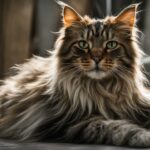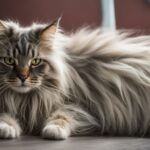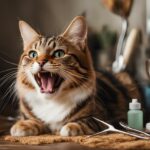As a cat owner, I have often wondered why older cats are more prone to getting matted fur. It turns out, there are several reasons behind this common issue. In this guide, I will explore the causes of matted fur in aging cats and provide valuable insights into how to prevent and manage this problem.
Key Takeaways:
- Older cats may develop matted fur due to various age-related challenges.
- Dental problems, degenerative joint disease, and urinary, bladder, and kidney issues are common causes of matted fur in aging cats.
- Grooming plays a crucial role in maintaining a high quality of life for senior cats.
- Regular grooming techniques, such as using brushes and combs, can help prevent and manage matted fur.
- Seeking veterinary care and professional grooming services may be necessary for severe cases of matted fur or underlying health issues.
Dental Issues and Matted Fur in Senior Cats
Cats with dental issues may experience pain or discomfort while grooming, leading to a decrease in grooming behavior and the development of matted fur. Regular dental care, including professional cleanings and at-home brushing, can help prevent dental problems and contribute to overall oral health.
Dental issues in cats can range from damaged teeth to infected gums. These issues can make it difficult for cats to groom themselves properly, resulting in mats forming in their fur. Proper dental care is essential not only for preventing matted fur but also for maintaining the overall health and well-being of senior cats.
Dental Care Tips for Senior Cats:
- Provide regular dental cleanings by a veterinarian to remove plaque and tartar buildup.
- Brush your cat’s teeth regularly using a soft-bristled toothbrush and cat-specific toothpaste.
- Offer dental treats or toys designed to promote oral health and reduce tartar buildup.
- Monitor your cat’s eating habits and look for signs of dental pain or discomfort, such as difficulty chewing or bad breath.
By addressing dental issues and maintaining good oral hygiene, cat owners can help prevent matted fur and ensure their senior cats enjoy a healthy and comfortable life.
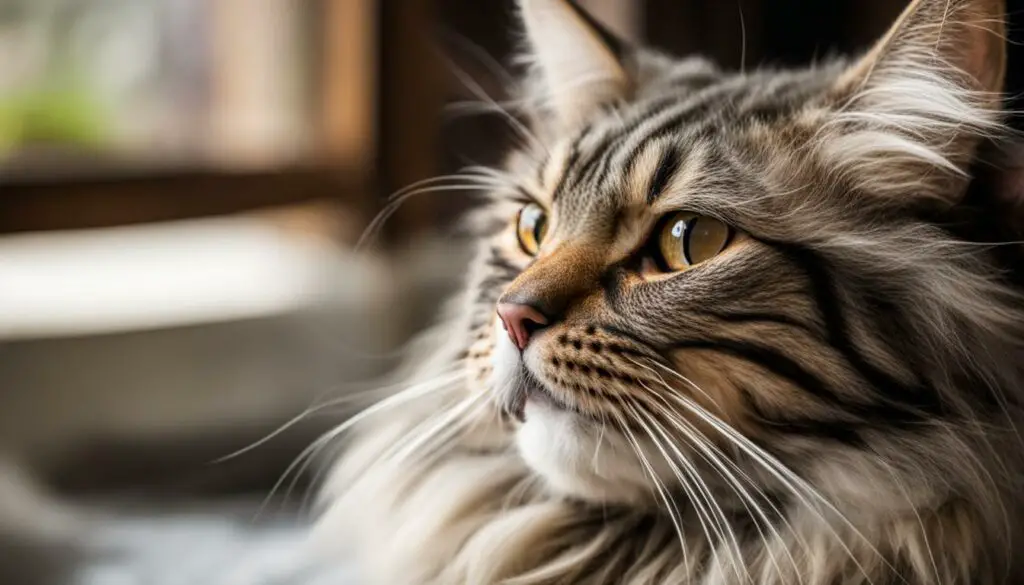
Degenerative Joint Disease and Matted Fur in Senior Cats
As cats age, they may develop degenerative joint disease, also known as osteoarthritis. This condition can cause discomfort and reduced mobility in senior cats, making it difficult for them to groom themselves properly. The result? Matted fur. Approximately 90% of cats aged 12 and older have some degree of degenerative joint disease, highlighting the importance of addressing this issue when it comes to maintaining the overall health and well-being of our senior feline friends.
Degenerative joint disease affects the cat’s ability to move freely, especially in areas such as the hips, hind legs, and underside. As a result, these areas often become neglected in terms of grooming, leading to matting. The mats can become tight and painful, causing further discomfort for the cat. Therefore, it’s crucial to provide appropriate care and support for cats with degenerative joint disease to alleviate their discomfort and improve their grooming habits.
The best approach to managing degenerative joint disease in cats is through a combination of treatments. This may include providing joint supplements to support joint health, administering pain medication to alleviate discomfort, and making modifications to the cat’s environment to reduce strain on their joints. By addressing the underlying cause and providing targeted care, we can improve the quality of life for senior cats and help prevent matted fur resulting from degenerative joint disease.
To summarize, degenerative joint disease can significantly impact a senior cat’s grooming abilities, leading to matted fur. By recognizing and addressing this condition, we can provide the necessary care and support to improve the cat’s comfort and prevent matting. Regular veterinary check-ups and a comprehensive approach to managing degenerative joint disease are essential for maintaining the health and well-being of our aging feline companions.
Urinary, Bladder, and Kidney Issues and Matted Fur in Senior Cats
Senior cats may experience urinary, bladder, and kidney issues that can contribute to matted fur. These health problems can interfere with their ability to keep themselves clean after using the litter box, resulting in soiled fur that can easily become matted. It’s important to understand the connection between urinary issues and matted fur in senior cats, as well as the steps you can take to prevent and address this problem.
Urinary tract infections, bladder stones, and kidney disease are common urinary issues that can affect senior cats. These conditions can cause discomfort and frequent urination, leading to soiled fur around the genital area. The damp fur is prone to matting, especially if the cat cannot groom themselves properly. If you notice that your senior cat has matted fur in this area, it is crucial to seek veterinary care to diagnose and treat any underlying urinary issues.
Preventing matted fur in senior cats with urinary issues involves regular litter box maintenance and cleaning. Ensure that the litter box is kept clean and odor-free, as cats may avoid using a dirty litter box. Providing easy access to a litter box with low sides and using a litter that is easy to dig in can also help senior cats with mobility issues maintain good litter box hygiene. Regular veterinary check-ups are essential to monitor the urinary health of senior cats and detect any issues early on.
Table: Common Urinary Issues and Matted Fur in Senior Cats
| Urinary Issue | Symptoms | Treatment |
|---|---|---|
| Urinary Tract Infections | Increased frequency of urination, straining to urinate, blood in urine | Antibiotics, increased water intake, dietary changes |
| Bladder Stones | Straining to urinate, frequent urination, blood in urine, reduced appetite | Surgery, dietary changes, medication to dissolve stones |
| Kidney Disease | Increased thirst, increased urination, weight loss, vomiting | Medication, special diet, fluid therapy |
It’s important to address urinary issues promptly to prevent discomfort and complications for your senior cat. By managing their urinary health and ensuring a clean litter box environment, you can help prevent matted fur and promote their overall well-being.
The Importance of Keeping Your Senior Cat Well-Groomed
Grooming plays a vital role in maintaining the well-being of senior cats. As cats age, they may face various challenges that can affect their grooming habits, leading to matted fur. Regular grooming sessions are essential to prevent matting and keep your senior cat comfortable.
Older cats often experience changes in their dental health, joint mobility, and urinary function, which can contribute to matted fur. By keeping a close eye on these areas and addressing any issues promptly, you can help prevent matting in your senior cat.
Regular grooming is crucial for senior cats to maintain a high quality of life. A poor-quality coat that is left unkempt can easily become matted.
The act of grooming not only helps to keep your cat’s coat clean and free from tangles, but it also provides an opportunity for you to bond with your feline companion. By gently brushing your cat’s fur, you can stimulate blood circulation, distribute natural oils, and remove loose hair, reducing the risk of matting.
It is important to approach grooming sessions with patience and gentleness, especially with senior cats who may have sensitive skin or joint discomfort. By creating a calm and positive grooming environment, you can help your senior cat associate grooming with relaxation and enjoyment.
Regular grooming, combined with veterinary care and a balanced diet, can contribute to the overall health and well-being of your senior cat. By taking the time to care for your feline friend’s grooming needs, you are ensuring a comfortable and happy life for them in their golden years.
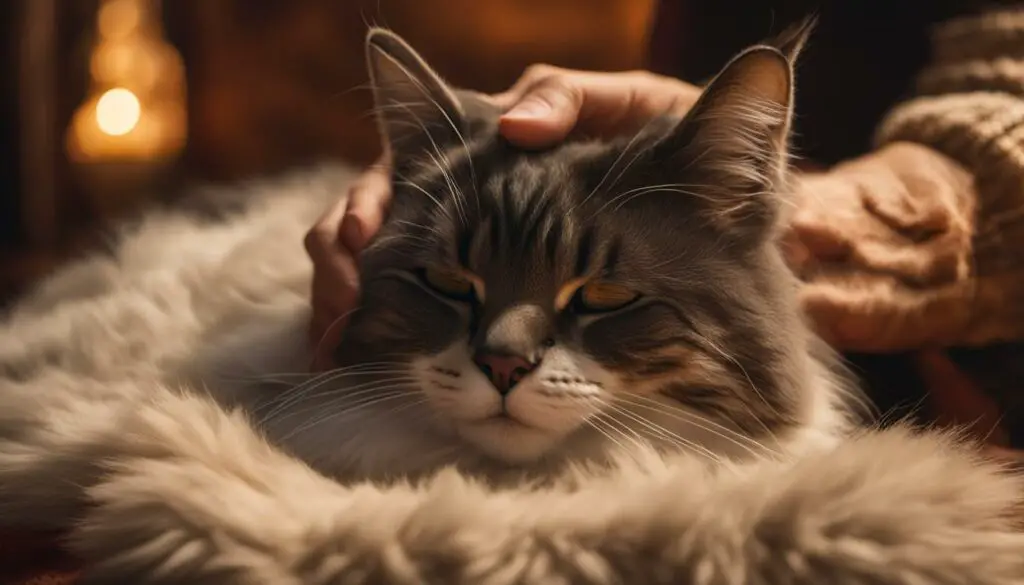
Grooming Techniques for Senior Cats: How to Detangle Matted Fur
Grooming plays a crucial role in maintaining the health and comfort of senior cats. As they age, cats may experience challenges with grooming, including matted fur. To keep your senior feline friend looking and feeling their best, here are some effective grooming techniques to detangle matted fur:
- Assisted Grooming: Spend a few minutes every day assisting your cat with grooming. Use a rubber brush, soft-pin slicker brush, and a stainless steel comb to work through the coat and target mats. Be extra gentle when grooming sensitive areas such as the hips, hind legs, and underside, as mats commonly form in these areas.
- Using Cornstarch: If your cat’s fur has become matted, applying a little cornstarch can help. Sprinkle a small amount of cornstarch onto the mat and gently work it into the fur. This can help loosen the knots and make it easier to comb through the mat without causing discomfort to your cat.
- Seeking Professional Assistance: If the matting is severe or if your senior cat is resistant to grooming, it may be beneficial to seek the assistance of a professional cat groomer. They have the necessary skills and experience to handle difficult fur and grooming behaviors, ensuring your cat’s comfort and safety during the grooming process.
Grooming should be a positive and stress-free experience for your senior cat. Remember to provide plenty of praise, treats, and breaks during the grooming sessions to keep your cat comfortable and cooperative. Additionally, maintaining regular veterinary check-ups and addressing any underlying health issues can contribute to improved grooming habits and prevent future matting.
Other Tools and Products for Grooming Senior Cats
When it comes to grooming senior cats, having the right tools and products can make a significant difference in maintaining their coat and overall comfort. Here are some essential cat grooming tools and products that can help you keep your senior feline friend looking and feeling their best.
Grooming Tools:
- De-matting comb: This tool is designed to gently remove mats from your cat’s fur without causing discomfort.
- Cat flea comb: A flea comb can be useful for removing any fleas or flea dirt from your cat’s coat, ensuring their skin stays healthy.
- Cat nail clippers: Trimming your cat’s nails regularly can prevent them from becoming too long or sharp, reducing the risk of scratches and accidental injuries.
- Bristle brush: A bristle brush is great for daily brushing to remove loose hair and distribute natural oils, keeping your cat’s coat shiny and healthy.
Detangling Spray:
For senior cats with prone to matting, a detangling spray can be a lifesaver. These sprays help to loosen tangles and make the combing process easier and more comfortable for your cat. Look for a detangling spray specifically designed for cats that is gentle and safe for their delicate skin.
Professional Grooming Services:
If you’re struggling to groom your senior cat at home or if they have difficult fur or grooming behaviors, seeking the assistance of a professional cat groomer can be beneficial. Professional groomers have the expertise and specialized tools to handle challenging grooming situations, ensuring your cat’s coat is well-maintained and mat-free.
Remember, grooming is an important aspect of senior cat care, and with the right tools and products, you can keep your furry companion comfortable and looking their best.
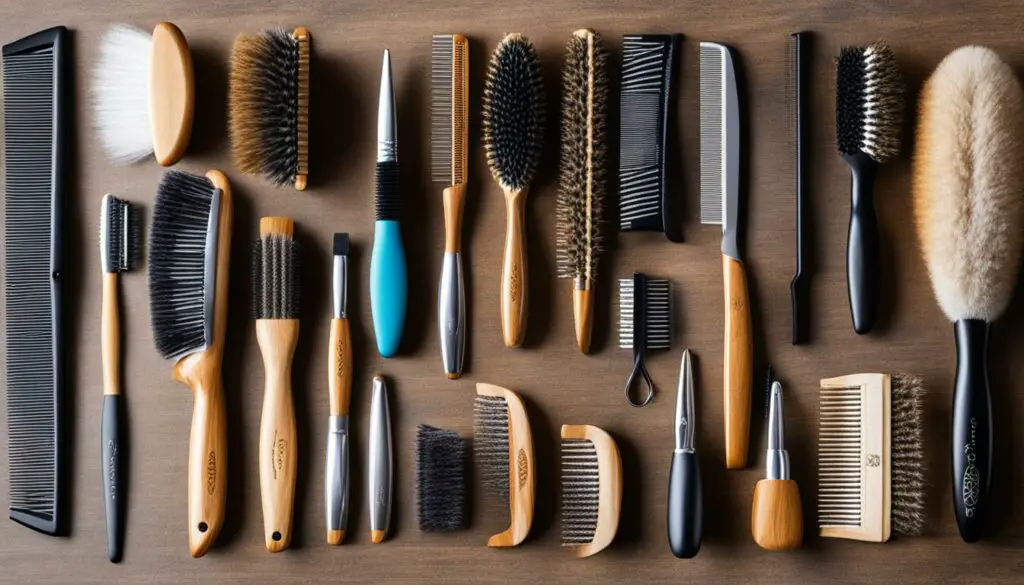
When to Seek Veterinary Care for Matted Fur in Senior Cats
If you notice that your senior cat has developed matted fur and has reduced or stopped grooming themselves, it is important to seek veterinary care. Matted fur in senior cats can be a sign of underlying health issues that require attention. Consulting with a veterinarian can help determine the cause of the change in grooming behavior and ensure appropriate treatment is provided.
Regular veterinary check-ups are also crucial for monitoring the overall health of senior cats. These check-ups can help detect any underlying health issues, such as dental problems, arthritis, or oral injuries, which can contribute to matted fur. Addressing these health issues promptly can prevent further discomfort for your cat and ensure their well-being.
When to Visit the Vet for Matted Fur:
- If your senior cat has matted fur and has reduced or stopped grooming themselves.
- If you notice any changes in your cat’s grooming behavior or overall health.
- If your cat shows signs of pain or discomfort while grooming.
“Regular veterinary check-ups are crucial for monitoring the overall health of senior cats.”
Taking proactive measures by visiting the vet for matted fur in senior cats can lead to early detection and treatment of potential health issues. Your veterinarian can provide personalized advice on grooming techniques and recommend suitable products to maintain your senior cat’s coat health.
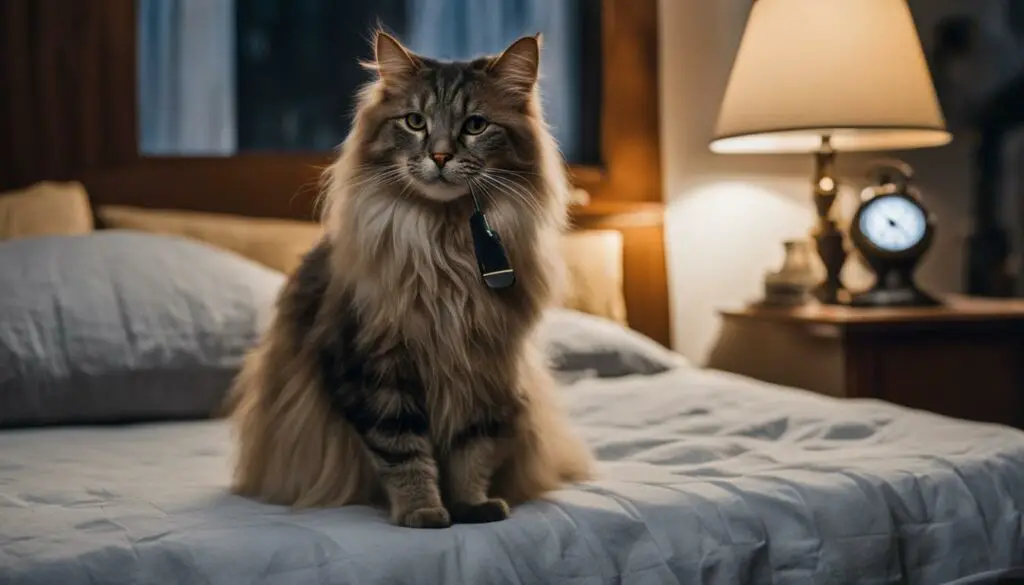
| Signs to Watch For | Actions to Take |
|---|---|
| Matted fur and reduced grooming behavior in senior cats | Consult with a veterinarian to determine the underlying cause and appropriate treatment |
| Changes in grooming behavior or overall health | Visit the vet for thorough check-up and evaluation |
| Pain or discomfort while grooming | Seek immediate veterinary care to address the underlying issue |
Why Does Cat Fur Mat?
Cat fur can become matted due to various reasons. Shedding hair from the undercoat can get tangled with the top coat, leading to mats. Cats can also develop mats when their fur becomes dirty or oily. Areas of the body that experience a lot of movement, such as the collar area, between the legs, under the chest, and at the base of the tail, are more prone to matting.
Causes of Cat Fur Matting
There are several factors that can contribute to matting in cat fur:
- Poor grooming habits: Cats who are unable to groom themselves properly, whether due to age, underlying health issues, or mobility limitations, may develop mats in their fur.
- Long or thick fur: Cats with long or thick fur are more prone to matting, as the hair can easily become tangled and knotted.
- Dirty or oily fur: Dirt, debris, and natural oils can cause the fur to clump together and form mats.
- Underlying health issues: Cats with certain health conditions, such as allergies, skin infections, or parasites, may be more susceptible to matting.
To prevent matting, regular grooming is essential. This includes brushing your cat’s fur to remove loose hair and prevent tangles, as well as keeping their fur clean and free from dirt and oils. In some cases, professional grooming may be necessary to remove stubborn mats and ensure the overall health and well-being of your cat.
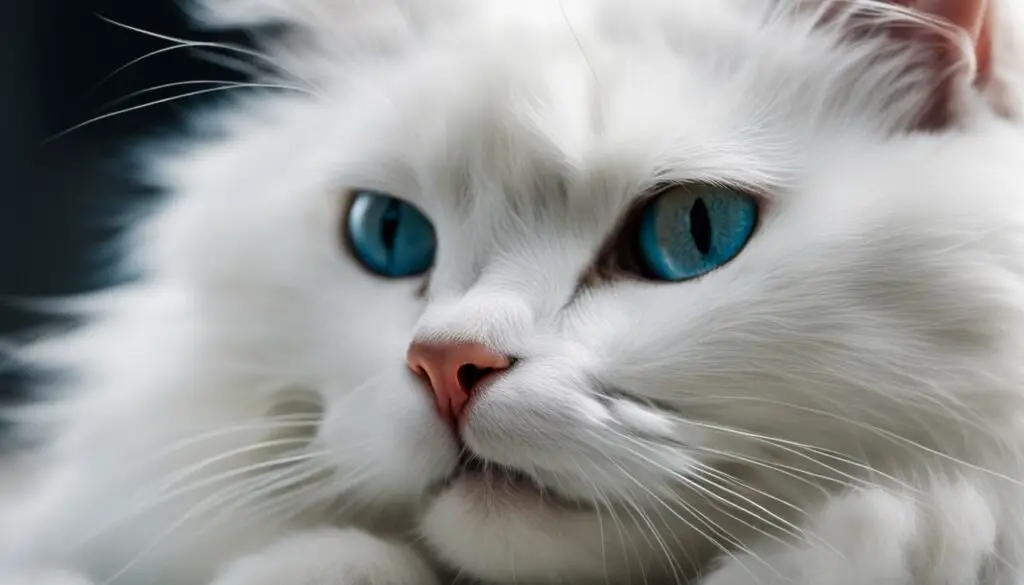
Table: Common Causes of Cat Fur Matting
| Cause | Description |
|---|---|
| Poor grooming habits | Cats who are unable to groom themselves properly, whether due to age, underlying health issues, or mobility limitations, may develop mats in their fur. |
| Long or thick fur | Cats with long or thick fur are more prone to matting, as the hair can easily become tangled and knotted. |
| Dirty or oily fur | Dirt, debris, and natural oils can cause the fur to clump together and form mats. |
| Underlying health issues | Cats with certain health conditions, such as allergies, skin infections, or parasites, may be more susceptible to matting. |
By understanding the reasons for cat fur matting and taking proactive measures to prevent it, you can help your feline companion maintain a healthy and comfortable coat.
Health Issues and Cat Fur Matting
When it comes to cat fur matting, it’s important to recognize that it can be a sign of underlying health issues in our feline companions. Cats who are not feeling well may spend less time grooming themselves, resulting in mats forming in their fur. These mats can be more than just a cosmetic issue, as they can indicate problems such as dental issues, arthritis, and oral injuries.
Cats with dental problems, such as damaged teeth or infected gums, may experience pain or discomfort while grooming, leading to a decrease in grooming behavior and the development of mats. Additionally, cats with degenerative joint disease, or osteoarthritis, may find it difficult to groom themselves properly, resulting in matted fur. These health issues can contribute to decreased grooming behavior, making it essential to seek veterinary care for proper diagnosis and treatment.
Regular veterinary care is crucial to address these health issues and prevent further discomfort for our feline friends. By visiting a veterinarian, we can determine the underlying cause of the change in grooming behavior and receive guidance on appropriate treatment options. Remember, addressing the health issues that may contribute to cat fur matting is key to maintaining the overall well-being of our senior cats.
| Health Issues | Signs and Symptoms |
|---|---|
| Dental Problems | Pain or discomfort while grooming, damaged teeth, infected gums |
| Degenerative Joint Disease (Osteoarthritis) | Difficulty grooming, decreased mobility, joint pain |
| Oral Injuries | Inflammation, wounds, or trauma to the mouth |
By addressing these health issues and providing appropriate treatment, we can not only help prevent cat fur matting but also improve our senior cats’ overall quality of life. Regular veterinary check-ups and open communication with our veterinarians are essential in proactively detecting and managing these health issues.
How to Remove Mats from Cat Fur
Mats in a cat’s fur can be uncomfortable and even painful for them. It’s important to gently remove these mats to prevent any further discomfort. Here are some effective grooming techniques for removing mats:
1. De-matting Comb
A de-matting comb is a useful tool for detangling and removing mats from the cat’s fur. Hold the mat close to the skin and use short strokes with the comb to gently loosen the tangles. Be careful not to pull or tug too hard, as this can cause discomfort or pain for the cat.
2. Cornstarch Method
If the mat is not too severe, you can try the cornstarch method. Apply a small amount of cornstarch to the mat and gently work it into the tangles using your fingers. This can help to loosen the mats and make them easier to comb out.
3. Seek Professional Grooming Assistance
If the mats are severe or difficult to remove, it may be necessary to seek professional grooming assistance. Professional groomers have the experience and tools to safely and effectively remove mats without causing any harm to the cat. They can also provide guidance on maintaining the cat’s coat health at home.
Remember, never use scissors or other sharp tools to cut out mats, as this can risk injury to the cat. It’s important to approach mat removal with patience and care, ensuring the well-being and comfort of your furry friend.
| Grooming Technique | Description |
|---|---|
| De-matting Comb | Use short strokes to gently loosen and remove mats |
| Cornstarch Method | Apply cornstarch to the mat and work it in to make it easier to comb out |
| Professional Grooming Assistance | Seek the help of professional groomers for severe or difficult mats |
Preventing Cat Fur Matting
Grooming plays a crucial role in preventing cat fur matting and maintaining a healthy coat for our feline companions. Regular grooming sessions help remove loose hair, prevent tangles and mats, and promote a comfortable and happy cat. Here are some effective tips to prevent cat fur matting:
1. Brushing and Combing
Regular brushing and combing are essential for preventing matting, especially for longhaired cats. Use a suitable brush or comb for your cat’s fur type and gently work through the coat, paying attention to areas prone to matting, such as behind the ears, under the armpits, and around the tail. This helps remove loose hair and prevent it from tangling with the top coat.
2. Regular Baths
Occasional baths can help keep your cat’s fur clean and prevent oil buildup, which can contribute to matting. Use a cat-friendly shampoo and follow proper bathing techniques to ensure a positive experience for your cat. Consult with your veterinarian for guidance on the frequency of baths based on your cat’s individual needs.
3. Trimming Long Fur
If you have a longhaired cat, regular trimming of the fur can help prevent mats from forming. Pay particular attention to the areas prone to matting and gently trim any knots or tangles. Be cautious while using scissors and consider seeking professional grooming assistance if necessary.
By incorporating these preventive measures into your cat’s grooming routine, you can minimize the risk of matting and maintain a healthy and beautiful coat for your furry friend.
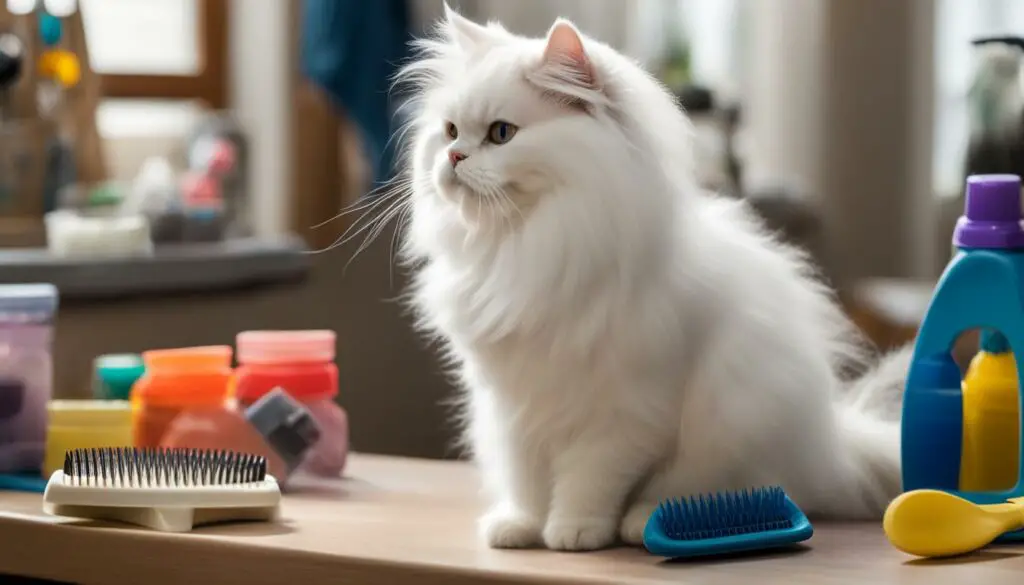
| Grooming Tips for Preventing Cat Fur Matting |
|---|
| Regularly brush and comb your cat’s fur to remove loose hair and prevent tangling. |
| Give your cat occasional baths using cat-friendly shampoo to keep their fur clean. |
| Trim the fur of longhaired cats to prevent mats from forming. |
The Dangers of Matting in Cats
Matting in cats can have several health implications and risks that pet owners should be aware of. When fur becomes matted, it can cause discomfort and pain for cats. As mats become tighter, they can irritate the skin, leading to inflammation and potential skin infections. This can be particularly problematic for senior cats, as their skin becomes thinner and more vulnerable to injuries. Additionally, mats can restrict a cat’s movement, making it difficult for them to groom themselves properly and exacerbating existing health issues.
Furthermore, mats can hide underlying skin and fur issues such as parasites and ticks. These can go unnoticed for extended periods of time, causing further harm to the cat’s health. Regular grooming and prompt removal of mats are crucial to prevent these risks and maintain optimal feline health. If a cat’s fur is severely matted or if the mats are affecting the skin, it is advisable to seek professional grooming services or consult with a veterinarian for appropriate intervention.
To summarize, the dangers of matting in cats include:
- Discomfort and pain
- Skin irritation and inflammation
- Infections
- Restricted movement
- Hidden parasites and ticks
By understanding these risks and taking proactive measures to prevent and address matting, pet owners can ensure the well-being and comfort of their beloved feline companions.
Table: Health Implications and Risks of Matting in Cats
| Health Implications | Risks |
|---|---|
| Discomfort and pain | Restricted movement |
| Skin irritation and inflammation | Hidden parasites and ticks |
| Infections |
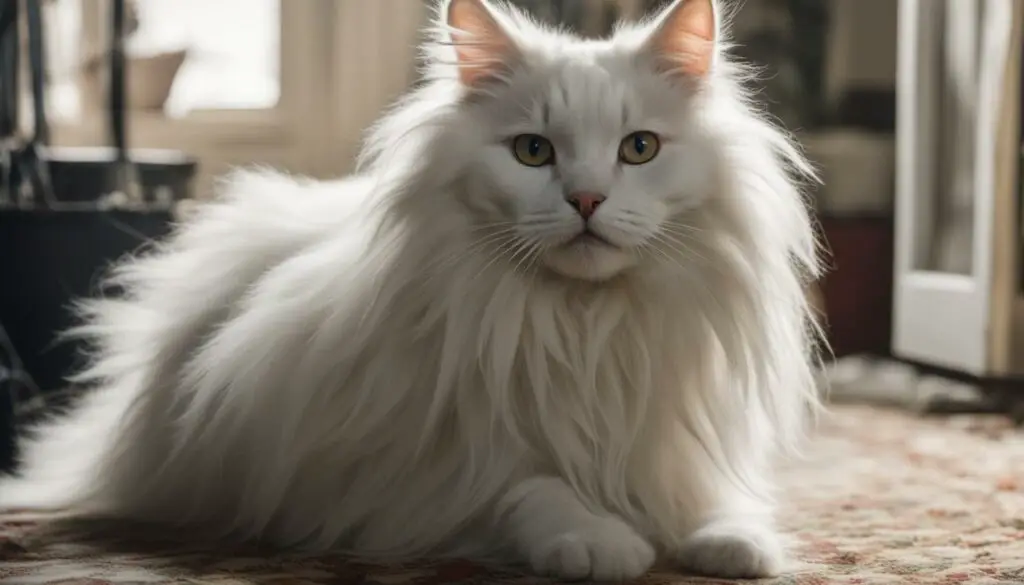
The Role of Regular Body Scans in Preventing Matting
Regular body scans of your cat can play a crucial role in preventing matting and detecting potential health issues early on. By running your hands through your cat’s fur regularly, you can check for any mats that may be forming and address them immediately. Additionally, pay attention to any changes in your cat’s grooming habits or behavior, as they can be indicators of underlying health concerns.
Early detection of matting can help prevent discomfort for your cat and minimize the risk of more severe health issues developing. Regular body scans allow you to identify mats in their early stages when they are easier to remove and less likely to cause skin irritation or infection. By addressing matting promptly, you can ensure the overall well-being and comfort of your feline companion.
During a body scan, pay extra attention to areas prone to matting, such as the collar area, between the legs, under the chest, and at the base of the tail. These areas often experience a lot of movement and can easily develop mats. By thoroughly inspecting these regions, you can take preventive measures to minimize matting and maintain your cat’s coat in a healthy condition.
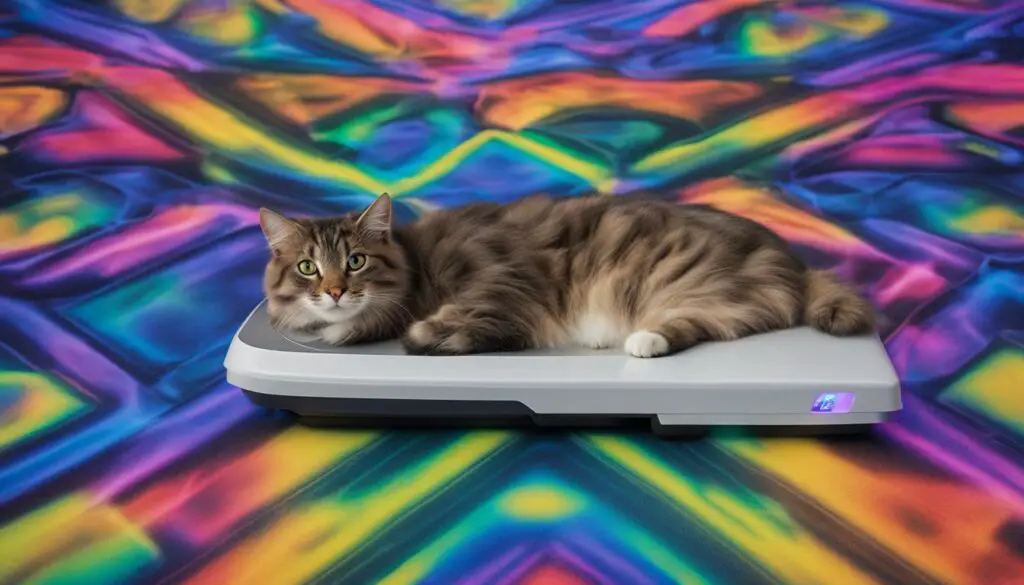
Importance of Veterinary Check-ups
In addition to regular body scans at home, it is important to schedule regular veterinary check-ups for your cat. Veterinarians are trained to detect any health issues that may not be apparent during routine grooming sessions. They can provide a comprehensive examination, including a thorough assessment of your cat’s coat and skin. By partnering with your veterinarian, you can ensure that any underlying health concerns are addressed promptly, further reducing the risk of matting and promoting your cat’s overall well-being.
Professional Grooming for Cats with Difficult Fur or Resistance to Home Grooming
Grooming can be a challenging task for cats with difficult fur or those who resist home grooming. In such cases, seeking professional grooming services can be a beneficial option. Professional groomers have the expertise and experience to handle cats with challenging grooming behaviors, ensuring a thorough and effective grooming experience.
Professional groomers can effectively remove mats from cat fur, which is crucial for cats with chronic matting issues. They have specialized tools and techniques to detangle and remove mats without causing discomfort or injury to the cat. Additionally, professional groomers can provide guidance on maintaining optimal coat health at home, including recommendations for grooming tools and techniques.
For cats with resistance to home grooming, a professional grooming session can be less stressful. Professional groomers are trained to handle cats with patience and care, minimizing stress and anxiety during the grooming process. This can be particularly beneficial for cats who become aggressive or anxious during grooming sessions at home.
Grooming Assistance for Difficult Cats
If you have a cat with difficult fur or resistance to home grooming, it is important to find a professional groomer who specializes in grooming cats. Look for groomers who have experience working with cats and who prioritize the comfort and well-being of the animals in their care.
When selecting a professional groomer, consider their grooming techniques and the products they use. Ensure that they use gentle and cat-friendly grooming products that are suitable for your cat’s specific needs. It is also essential to discuss any specific concerns or requirements with the groomer beforehand, such as sensitive areas or medical conditions.
Remember, professional grooming services can be a valuable resource for maintaining the coat health and overall well-being of cats with difficult fur or resistance to home grooming. By entrusting your cat’s grooming needs to a professional, you can ensure that they receive the care they deserve while minimizing stress and discomfort during the grooming process.
Conclusion
Proper grooming plays a vital role in ensuring the well-being of senior cats. By following a few grooming tips, you can help maintain a healthy coat and prevent matted fur in your aging feline friend.
Firstly, be aware of the common causes of matted fur in older cats. Dental issues, degenerative joint disease, and urinary, bladder, and kidney problems can all contribute to matting. Regular veterinary check-ups and appropriate treatment can address these underlying health issues.
Secondly, establish a grooming routine that includes daily combing sessions for longhaired cats. Focus on problem areas such as the collar, legs, chest, and tail base, where mats are prone to form. Additionally, consider seeking professional grooming services for cats with difficult fur or resistance to home grooming.
Lastly, be mindful of the dangers of matting. Tight mats can cause discomfort, restrict movement, and hide underlying skin and fur issues. Regular body scans and prompt removal of mats are essential in preventing these risks and maintaining optimal feline health.
Remember, a little effort in grooming can go a long way in ensuring a high quality of life for your senior cat. By prioritizing their grooming needs and seeking veterinary care when necessary, you can help keep your feline companion comfortable, happy, and looking their best.
FAQ
Why do old cats get matted fur?
Old cats can develop matted fur due to various age-related challenges, such as dental problems, degenerative joint disease, and urinary, bladder, and kidney issues. These conditions can affect their grooming behavior and lead to matting.
How can dental issues contribute to matted fur in senior cats?
Cats with dental problems, such as damaged teeth or infected gums, may experience pain or discomfort while grooming, leading to a decrease in grooming behavior and matted fur.
What is degenerative joint disease, and how does it cause matted fur in senior cats?
Degenerative joint disease, or osteoarthritis, is a common condition in older cats that can make it difficult for them to groom themselves properly, resulting in matted fur.
Can urinary, bladder, and kidney issues contribute to matted fur in senior cats?
Yes, cats with urinary tract infections or other bladder and kidney issues may have difficulty keeping themselves clean during and after using the litter box, leading to soiled fur and matting.
Why is regular grooming important for senior cats?
Regular grooming is crucial for senior cats to maintain a high quality of life. Matted fur can cause discomfort, especially since their skin becomes thinner and more prone to injuries as they age. Frequent, gentle grooming sessions can help prevent matted fur and keep senior cats comfortable.
How can I groom an old cat with matted fur?
When grooming an old cat with matted fur, it is important to spend a few minutes every day on assisted grooming. Using a rubber brush, soft-pin slicker brush, and stainless steel comb can help work through the coat and target mats. Applying a little cornstarch and gently pulling apart the knots can also help. Seeking the assistance of a professional cat groomer may be beneficial.
What other grooming tools and products can be useful for senior cats?
Other grooming tools and products that can be useful for senior cats include a cat flea comb, cat nail clippers, soft cotton gauze pads for cleaning sensitive areas, a detangling spray, and a bristle brush.
When should I seek veterinary care for matted fur in senior cats?
If you notice your senior cat has stopped or reduced grooming themselves and has matted fur, it is advisable to visit a veterinarian. They can help determine the underlying cause of the change in grooming behavior and provide appropriate treatment. Regular veterinary check-ups are also important to monitor the overall health of senior cats.
Why does cat fur mat?
Cat fur can become matted due to various reasons, including shedding hair from the undercoat getting tangled with the top coat and dirt or oil accumulating in the fur.
Can matted fur be a sign of underlying health issues in cats?
Yes, matted fur can be a sign of underlying health issues in cats. Cats who are not feeling well may spend less time grooming themselves, resulting in mats. Health issues such as dental problems, arthritis, and oral injuries can contribute to decreased grooming behavior and matted fur.
How can I remove mats from my cat’s fur?
Mild mats can be combed out at home using a de-matting comb. It is important to hold the mat close to the skin and use short strokes to prevent pulling and causing discomfort to the cat. Professional grooming may be necessary for severe mats or mats affecting the skin. It is crucial to never use scissors to cut out mats as it can cause injury to the cat.
How can I prevent cat fur from matting?
Regular grooming sessions are the best way to prevent cat fur from matting. Longhaired cats, in particular, require daily combing to prevent tangles and mats. Establishing a routine and making grooming sessions positive and stress-free can help encourage cats to tolerate and even enjoy grooming.
What are the dangers of matting in cats?
Matting can cause discomfort and pain for cats. As mats become tighter, they can irritate the skin, restrict movement, and hide underlying skin and fur issues such as parasites and ticks. The skin under the mats can become inflamed and infected, requiring veterinary intervention.
How can regular body scans help prevent matting in cats?
Regular body scans of your cat can help detect potential health issues and prevent matting. By running your hands through your cat’s fur, you can check for mats and address them immediately. Additionally, any changes in behavior or grooming habits should be reported to your veterinarian for further evaluation.
Can professional grooming help cats with difficult fur or resistance to home grooming?
Yes, cats with difficult fur or those who resist home grooming may benefit from professional grooming services. Professional groomers have the necessary skills and tools to handle cats with challenging fur or grooming behaviors. They can effectively remove mats, provide a thorough grooming experience, and offer guidance on maintaining optimal coat health at home.
Source Links
- https://be.chewy.com/senior-cats-need-special-grooming/
- https://www.allpetvoices.com/cat-fur-matting-why-it-happens-and-what-to-do-about-it/
- https://www.countrysideveterinaryclinic.org/services/cats/blog/matting-cats


